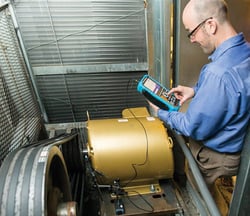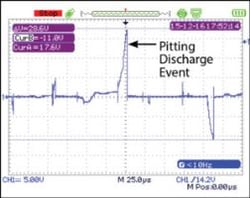We recently wrote about how the static resistance of an AEGIS ring (measured with a multimeter) is higher than the effective resistance when operating on a VFD-controlled motor. But the fact is that neither value is actually important to know.
Installing Colloidal Silver
When an AEGIS ring is installed with colloidal silver on the shaft, the resistance from frame-to-shaft is often under one ohm. Without colloidal silver, it will be higher, perhaps a few ohms. But our engineers have seen installations where fully-functional AEGIS rings' measured resistance was 30W. The ring was working; the bearings were protected. It's just that the resistance is not that important.
Shaft voltage is what damages motor bearings when it discharges through them. So it's the shaft voltage that you should measure to check whether the bearings are at risk.
Using an Oscilloscope for VFD-Controlled Motors
For VFD-controlled motors, you need an oscilloscope to do this. Using a scope with 100 MHz bandwidth or more lets you do two things:
First, it lets you check the maximum shaft voltage level. As a rule, shaft voltage less than 5V peak (10V peak-to-peak) is not a risk for motor bearings. You can check shaft voltage amplitude at timescales between 100 ms and 1 ms per division.
Second, and more importantly, you can check for discharge at smaller timescales. The smoking gun of discharge through the bearing is voltage building up over a few ms, and then suddenly dropping back to baseline (vertical line). If you check the shaft voltage and don't see any discharges, then the bearings are not being electrically damaged.
The takeaway is there is no harm in measuring the resistance of an AEGIS ring if you really want to, but the resistance doesn't tell whether the bearings are protected. For that, you need to measure the shaft voltage with an oscilloscope.
AEGIS Rings come with a 2-year extended warranty against bearing fluting damage. No other form of protection against VFD-caused bearing damage offers a warranty like this.

To learn more about AEGIS shaft grounding and best practices for electrical bearing protection, sign up for a training. We offer monthly live training webinars, and - pandemic restrictions permitting - we can also visit your facility to review your exact application.


